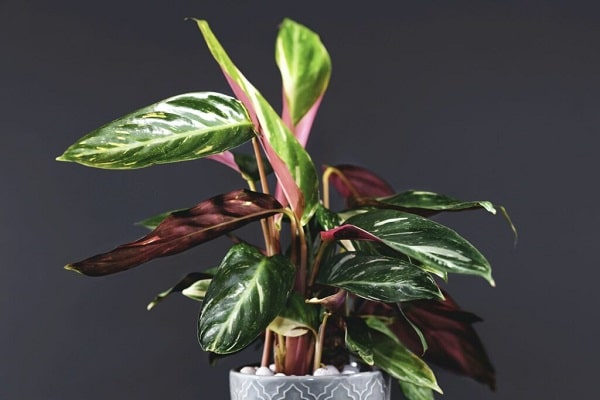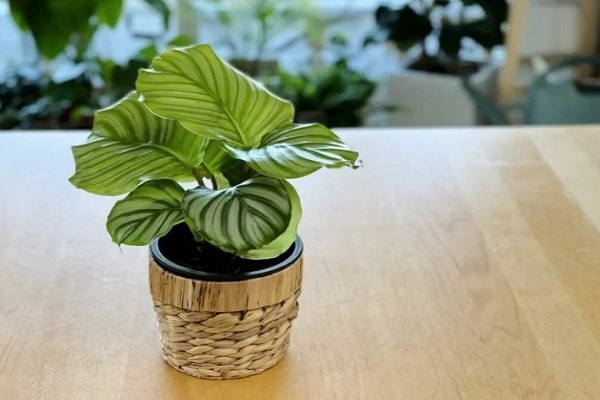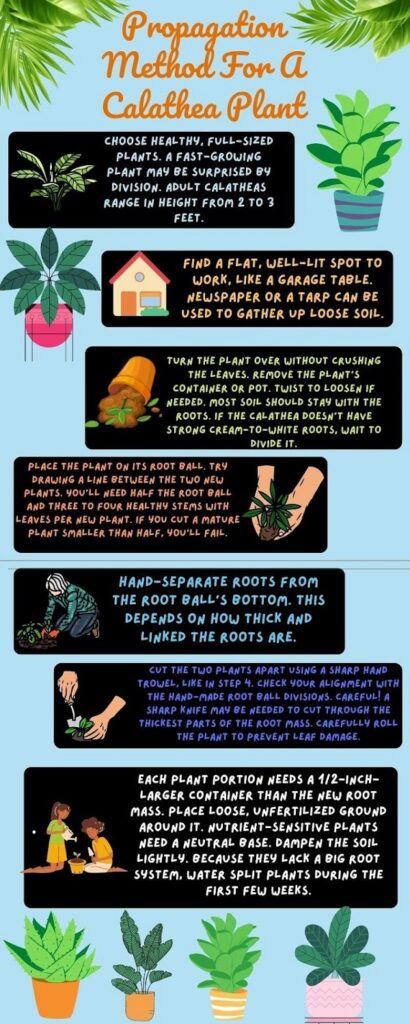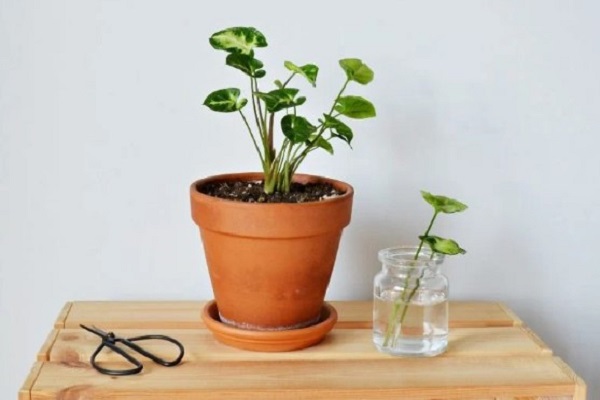Propagate Calathea plants are popular among houseplant enthusiasts for their striking foliage, which comes in a variety of colors and patterns. While purchasing new plants can be exciting, propagating Calathea plants can be a rewarding experience and a great way to expand your collection. Propagation of Calathea plants can be done through various methods such as division, stem cuttings, or leaf cuttings. Each method requires different techniques and timing, but with a little patience and care, you can easily propagate your Calathea plant and enjoy watching it grow.
In this article, we will explore the different methods of propagating Calathea plants, including the tools needed, the steps involved, and the care requirements for the new plants. Whether you’re a seasoned plant enthusiast or a beginner looking to try your hand at plant propagation, this guide will provide you with the information you need to successfully propagate your Calathea plants and enjoy the beauty of these stunning plants.
Quick Navigation
- 1 Is It Possible To Propagate Every Kind Of Calathea?
- 2 Can Calathea Plants Be Propagated From Seed, Cuttings, Leaves, Or Other Sources?
- 3 Best Time To Propagate Calathea Plants
- 4 Propagation Method For A Calathea Plant By Division
- 5 Aftercare Of The Propagation
- 6 Predictions Of Expanding
- 7 Frequently Asked Questions
- 8 In The End
Is It Possible To Propagate Every Kind Of Calathea?

Professionally, you can grow all plants in the genus Calathea and even the larger family Marantaceae. But this doesn’t mean that they will all grow well at home. Some varieties need special care or hormones to make roots, making it harder to grow healthy new plants at home than others. Calathea plants aren’t grown the same way as most other houseplants.
Can Calathea Plants Be Propagated From Seed, Cuttings, Leaves, Or Other Sources?

Calathea plants can’t be grown from cuttings like succulents and many other popular houseplants. Even if you leave a lot of the stem on a leaf, you cut off one of these plants and stick it in the soil, and the leaf will dry out. There’s also no chance that a small piece of stem or root will grow into a whole plant. And unlike some houseplants, Calathea doesn’t flower often enough to collect seed.
You can use a method called “division” instead. One of the simplest ways to get plants to grow more of themselves, but it can feel extreme or aggressive. But it is easy to do at home and works well.
If you don’t want to lose a Calathea, you shouldn’t try to split it up. Doing so will stress the whole plant.
Best Time To Propagate Calathea Plants
Calathea plant propagation is an excellent way to add more beautiful evergreen plants to your garden. In general, propagation is easiest in the spring and fall, but You can do it at any time of year with a little preparation.
Propagation Method For A Calathea Plant By Division

The division may be the only way to make more of this houseplant, but it’s not too hard to learn. To control the conditions around the new plant, you don’t have to make any specific cuts or build humidity chambers.
If you are careful and use a sharp-edged hand trowel, you should now have two Calathea plants where you only had one.
- Choose only healthy, fully grown plants close to their full size. If you split a plant that is still growing quickly, it may be shocked instead of encouraged. The size of an adult Calathea depends on the type, but most reach a height of two or three feet.
- Find a flat, well-lit place to work, such as a table or an area on the garage floor. You can put newspaper or a small tarp on the ground to make it easy to pick up loose soil.
- Gently turn the plant on its side, ensuring that none of the leaves are crushed. Slide the container or pot off of the roots of the plant. If you need to, twist it first to loosen it. Some soil will fall out, but most of it should stay with the roots. If the Calathea doesn’t have a strong root mass with cream-to-white roots, you might want to wait to divide it until it gets better.
- Set the plant up as best you can on its root ball. Look at the plant and try to picture a line between the two new plants. You will need nearly half of the root ball and at least three to four strong, healthy stems with leaves for each new plant. If you cut a mature plant into pieces that are smaller than half, you are likely to fail.
- From the bottom of the root ball, start separating the roots by hand. Whether or not this is possible depends on how thick the roots are and how tightly they are connected.
- Using a sharp hand trowel, start cutting from the top of the soil down to separate the two plants as you decided in step 4. Stop and often check to ensure you’re still in line with the divisions you made by hand in the root ball. Slow down and be careful. It’s hard work, so you might need a sharp kitchen knife or garden knife to cut through the thickest parts of the root mass in the middle. Try not to damage the plant’s leaves as you roll it around to get to its roots.
- Once the plant is cut in half, put each half in a container just 1/2 inch bigger than the new root mass. Fill in around it with a loose mix of loose soil that drains quickly and isn’t very fertilized. Plants that have just been split need a neutral base to start growing in because they are sensitive to nutrients. Lightly pack the soil and water it well until the whole soil mix is wet. Keep the plants that you split up well-watered for the first few weeks because they won’t have a large enough root system to keep themselves moist.
Aftercare Of The Propagation

Keep the Calathea plants in a warm, humid area for the first several weeks to give them time to recover from the shock of being divided.
The light levels should be kept low but constant. It’s possible that, at first, the plants will exhibit signs of shock, such as wilting or drooping, as well as browning the leaves. In reaction, you should refrain from using too much water at that point. This is analogous to repotting a calathea plant in a different container.
Give the plants time to recuperate gently and maintain the appropriate conditions. You will finally see them perk up. Strained leaves may never recover their original color, but new growth will quickly take their place.
In addition to this, be on the lookout for any common illnesses, pests, or insects that may affect your calathea plant.
Predictions Of Expanding
A Calathea division will likely remain stunted and shocked for a few months following this treatment, even if handled properly. But that doesn’t mean development won’t occur. A surprising growth spike from the plant could occur after three to four months.
Once the roots have grown deep enough, the plant will grow normally again, and new leaves will appear. Most Calathea plants grow normally again six months after being split up, and they can grow back to their original size in two to three years.
A larger plant is divided earlier, resulting in smaller divisions that mature more quickly.
Frequently Asked Questions
Can You Root Calathea In Water?
One potential method for propagating calathea plants is to root them in water. To do this:
- Take a pot or container with a good drainage system and fill it with fresh water.
- Cut off the bottom of a calathea plant, remove any brown or rotten roots and place the plant in the water.
- Replace the soil around the plant with fresh soil and wait until new roots grow out of the water.
How Long Does It Take To Propagate Calathea?
Calathea can take a while to grow roots after being split. If you keep the soil moist but not too wet, they should start growing new roots within a week to a month. The top of the plant may not grow for three months since the plant concentrates all of its energy on developing roots.
Can You Grow A Calathea Plant From A Broken Leaf?
In general, growing a new calathea plant from a broken leaf is impossible, as the plant must have at least one intact leaf to thrive. If the leaf is completely broken, the plant may still be able to survive and produce new leaves. Still, You may significantly impair its growth and development.
What Soil Is Best For Calathea?
When selecting a soil substrate for Calathea plants, there are numerous things to take into consideration. The type of soil, pH level, and amount of organic matter in the soil are all important considerations. Some soils are better suited for growing Calathea plants than others based on these factors.
Some general tips for choosing the best soil for growing Calathea plants include:
- Before you buy any plants or try to transplant them, you should test the soil’s pH. Plants of the genus Calathea are not recommended for use in acidic soils.
- Select soil that is well-drained and has good aeration. Clay soils are difficult to work with, but they are excellent substrates for growing Calathea plants.
- Make sure the soil has a good balance of organic matter and clay content. A too high clay content will make it difficult for the plant to absorb water and nutrients, while soil too high in organic matter can cause fungus problems.
- Choose soil that is dark in color but not too black. This will help to avoid problems with competing weeds.
- If you are growing Calathea plants in containers, select a pot that has been pre-treated with a fungicide or herbicide to prevent problematic fungi and bacteria from developing.
In The End
Propagating Calathea plants is a rewarding experience and a great way to expand your plant collection. Whether you choose to propagate through division, stem cuttings, or leaf cuttings, each method requires different techniques and care requirements. By following the steps outlined in this guide and providing the necessary care, you can easily propagate your Calathea plants and enjoy watching them grow.
Remember to be patient and gentle with your plants, as propagation can be a delicate process. With time and effort, you’ll be able to enjoy the beauty of your newly propagated Calathea plants and take pride in growing them from scratch. Whether you’re a seasoned plant enthusiast or a beginner looking to try your hand at propagation, this guide has provided you with the information you need to successfully propagate your Calathea plants and bring a touch of natural beauty into your home.

My name is Md Deloar Hossain and I’m the creator of Club Gardening, designed for all your gardening ideas, gardening product reviews, and a place to help you find the best gardening experience possible.


